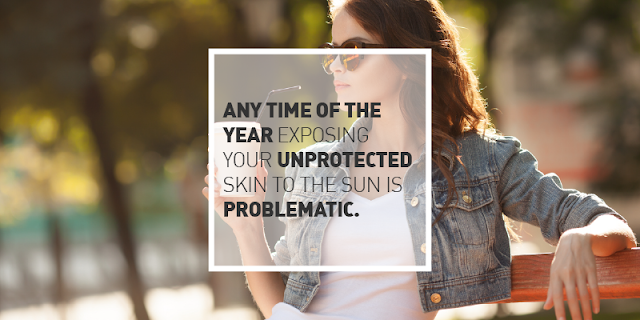In the spring the daylight lingers longer, which means that there is more radiation from the sun making its way to your location on earth. This radiation is in two forms, UVA and UVB. Both can cause significant damage to your skin, the damage that includes dehydration, burning, discoloration, wrinkles, and cancer. Skin cancer can be disfiguring and deadly. Most people know that in the heat of the summer they need to protect their skin from burns, but they are less aware of how dangerous the spring sun can be.
The Sun and Your Skin
Any time of the year exposing your unprotected skin to the sun is problematic. But, not everything about the sun is bad. Certainly, it helps us to create vitamin D, helps to regulate our mood and keep our spirits high, and provides the energy that plants need to grow. The concern is with the interaction of the UVA and UVB radiation and your cellular components. UV rays penetrate unprotected skin and their energy creates damage. UVB burns the top layers. UVA penetrates more deeply and can change your skin cells’ functionality and alter the DNA.
According to the National Institutes of Health:
DNA damage can cause changes to cells that make them rapidly grow and divide. This growth can lead to clumps of extra cells called a tumor, or lesion. These may be cancerous (malignant) or harmless (benign).
Skin cancer may first appear as a small spot on the skin. Some cancers reach deep into surrounding tissue. They may also spread from the skin to other organs of the body.
Each year, more than 2 million people are treated for 2 types of skin cancer: basal cell and squamous cell carcinoma. These cancers are seen in both older and younger people, and they’re rarely life-threatening.
Melanoma is a less common but more serious type of skin cancer that’s diagnosed in more than 68,000 Americans each year. Another 48,000 are diagnosed with an early form of the disease that involves only the top layer of skin. Melanomas arise from the cells that provide pigment (color) to the skin.
Your risk for melanoma is higher if members of your family have had skin cancer or if you’ve already had a melanoma or other skin cancers. A major risk factor for melanoma is having a large number of moles, or having large flat moles with irregular shapes. Sunburns, especially during childhood, may also raise your risk for melanoma.
Although your skin is constantly regenerating itself and has the power to heal, over time this regeneration becomes less effective. As you age the connective tissues in your skin that you may know as collagen and elastin break down. Sun exposure can make this happen more rapidly, leading to premature wrinkles. It also damages the pigment in your skin, causing hyperpigmentation, or sunspots, that indicate aging as well. Dermatologists and oncologists all agree that the benefits of the sun do not outweigh its dangers. And this danger is heightened in the spring.
Spring Sun Is Damaging Sun
The spring sun is so dangerous for two reasons.
First, after winter most people are at their most pale and so burn more quickly and easily. This is especially true for people who engage in outdoor sports that are limited in the winter, such as bicycling. The pigment in the skin helps to protect it from the sun’s harmful rays. In fact, research shows that melanin, the pigment, protects the skin against many cancers and against UV radiation. Light skinned people are 70 times more likely to develop skin cancer than those with very dark skin and melanin in dark skin is twice as effective at blocking UVB rays. In essence, this means that melanin acts as an SPF. This makes sense when you look at the distribution of skin tones in various locations around the planet.
The second reason the spring is so dangerous is that the cooler outdoor air temperature misleads people into thinking that the sun is not as intense. In fact, though, the sun is higher in the sky and its rays are more intense than they are in the middle of the summer. This means that you will experience sunburn with less time in the sun than you would otherwise.
Protecting Your Skin from the Sun
There are three essential strategies for protecting your skin from the sun.
- Avoid Damage. This means limiting your exposure to the sun’s harmful rays as much as possible. Wearing a full-spectrum SPF 30 or higher sunscreen every time you will be outside for any length of time is the best way to do this. Also, protective clothing and hats with tight-knit fabrics will block the sun’s radiation. Stick to the shade and get your ‘tan’ from artificial sources and your glow from an amazing assortment of cosmetics and skincare products that are on the market. Remember, the best treatment for sun damage is to not have any.
- Treat Damage. Depending on the extent of your sun damage this may mean something as simple as re-hydrating and moisturizing your skin or as complex as having skin cancer removed from your skin. Recovering from sunburn can be very painful. Make sure that you drink enough water and keep your skin moist, knowing that the damaged layer will peel away leaving new skin beneath it. The new skin should be protected from damage and you should make sure that you are nourishing that skin and the layers below it with the best skin care products you can find. If you have had surgery to remove skin cancer these same products can help. MDSUN has a whole line of products that can help to treat damaged skin.
- Repair Damage. The skin is an amazing organ and modern science has advanced its understanding of how to reverse signs of aging and sun damage. Some of this can be done through cosmetic procedures and some can be done with the application of skincare products that are formulated with DNA repair enzymes.
MDSUN, for instance, contains ultra pack technology, which is a highly-concentrated formulation of clinical-grade ingredients that promote dramatic results over time – without irritation, peeling, redness, or other common adverse effects. Used throughout MDSUN products, they incorporate a variety of comprehensive combinations of powerful ingredients: lipid- and water-soluble antioxidants and vitamins, alpha and beta hydroxyl, lipo hydroxy and polyhydroxy acids, amino acids, polyphenols, flavonoids and isoflavones, cytokinins, retinoid derivatives, multiple skin brightening components, botanical anti-inflammatories, natural skin barrier components, and a multitude of growth factors, peptides, and stem cells. The formulations are delivered in a specialized liposomal vehicle for enhanced stability, comfort, penetration, and efficacy.
While different MDSUN products contain different ultra packs, the intent is the same – to deliver a concentrated dose of the ingredients skin needs to enhance the appearance of a firmer, smoother texture with a luminous glow and even tone.
Skin Care Tips From MDSUN Skin Care®
Please Visit Our Official Website - MDSUN Skin Care




Comments
Post a Comment